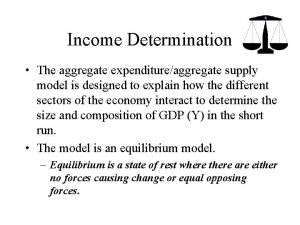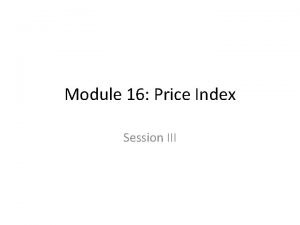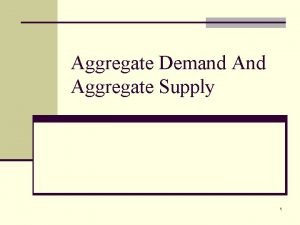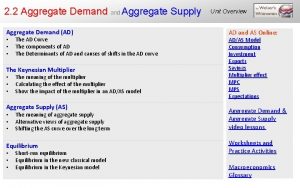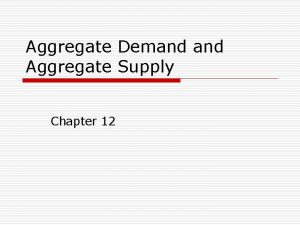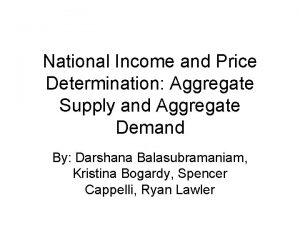National Income and Price Determination Aggregate Demand AP



















- Slides: 19

National Income and Price Determination: Aggregate Demand AP Economics Mr. Bordelon S

Aggregate Demand S Aggregate demand (AD) is a curve that shows the relationship between aggregate price level (APL) and the quantity of aggregate output demanded by households, firms, the government, and the rest of the world.

Why does AD have a downward slope? S To a certain extent this is due to the law of demand, but this would be misleading by itself. S The demand curve for any individual good shows how QD depends on the price of that good, holding prices of all other g/s and everything else constant. S AD focuses on the APL increasing for ALL g/s in the economy. S Fine. So what causes it then?

AD Slope 1. Wealth effect S When price level drops, purchasing power of existing financial assets (savings, for example) increases. This can increase consumer spending and there is a downward movement along the AD curve. S When price level increases, purchasing power of existing financial assets decreases. This can decrease consumer spending and there is an upward movement along the AD curve. S Think income effect!

AD Slope 2. Interest rate effect. S Decrease in APL means lower interest rates. This can increase spending. S Lower price level increases purchasing power of money you have on hand. Ultimately, you don’t need as much money to buy g/s. The decrease in demand for money on hand pushes interest rates down. S Nominal interest rate = real interest rate + expected inflation. S If inflation falls, so should the nominal interest rate. S Lower interest rates increase investment spending, and there’s a movement along AD as real GDP increases.

AD Slope 2. Interest rate effect. S Increase in APL means higher interest rates. This can decrease spending. S Higher price level decreases purchasing power of money you have on hand. You need more money to buy g/s. Increase in demand for money pushes interest rates up. S Nominal interest rate = real interest rate + expected inflation. S If inflation increases, so should the nominal interest rate. S Higher interest rates decrease investment spending, and there’s a movement along AD as real GDP decreases.

Example of the curve. Note the different notations on the axes and the curve. If you do not have the curve or axes labeled correctly, it’s wrong.

Shifts in AD There is no real difference in the mechanics of the graph when we talk about shifts of AD vs. D. There difference comes in how we view the changes from the macroeconomic point of view.

Shifts in AD S Just to clarify the rules on shifting the curve: S An increase in AD means a shift of AD to the right. Rightward shift occurs when aggregate QD increases at any given APL. S A decrease in AD means a shift of AD to the left. Leftward shift occurs when aggregate QD decreases at any given APL. S One other point: regardless of shift, the multiplier effect increases/decreases total spending throughout the economy.

Shifts in AD S Changes in expectations S When consumers and businesses see a healthy economy in the future, they will increase consumption and investment spending. AD shifts right. S When consumers and businesses see an economy going down in the future, they will decrease consumption and investment spending. Saving for a rainy day! AD shifts left.

Shifts in AD S Changes in wealth. NOT THE WEALTH EFFECT S If the value of assets increases, consumers increase consumption. We know this from the consumption function. AD shifts right. S If the value of assets decreases, consumers decrease consumption. AD shifts left. S AP Example. Stock market and real estate market tanking, cascade effect throughout the economy, shifting AD left.

Shifts in AD S Size of existing stocks (physical capital/inventories) S If firms have plenty of stock, investment spending slows down. If investment spending slows down, then AD shifts left. Not producing as much! S If firms have bare cupboards, investment spending will increase. If investment spending increases, then AD shifts right. Producing more! Woot.

Government Policies S Fiscal policy. Use of either government spending and transfers or tax policy to stabilize the economy. S Legislative and executive power here. S If government increases spending, this increases AD, shifting S S S right. If government decreases spending, this decreases AD, shifting left. If government raises taxes, this decreases AD, shifting left. If government lowers taxes, this increases AD, shifting right. If government transfers increase, this increases AD, shifting right. If government transfers decrease, this decreases AD, shifting left.

Government Policy S Monetary Policy. Use of change in quantity of money or interest rate to stabilize the economy. S Federal Reserve. S Fed increases money supply, households and firms have more money to lend. This drives interest rates down at any APL, leading to higher investment spending and consumer spending. AD shift right. S Fed decreases money supply, households and firms have less money to lend. This drives interest rates down at any APL, leading to lower investment spending and consumer spending. AD shifts left.

Summary of AD Shifts

Question 1 S For each of the following, draw a correctly labeled AD graph, and show each will affect the AD curve. 8 graphs. Citations from the text, and briefly explain. Business owners are less optimistic about the health of the economy. The government decreases welfare and veteran’s benefits. The Federal Reserve increases interest rates. A rising price level decreases the value of money held for purchases. The government lowers personal income taxes. Consumers expect the job market to be much stronger in the next few months. S The stock market has reached new records high levels of value. S The stock of physical capital has been falling for nearly a year. S S S

Question 2 S A fall in the value of the dollar against other currencies makes U. S. final goods and services cheaper to foreigners even though the U. S. aggregate price level stays the same. As a result, foreigners demand more American aggregate output. Your friend says that this represents a movement down the aggregate demand curve because foreigners are demanding more in response to a lower price. You, however, insist that this represents a rightward shift of the aggregate demand curve. Who is right? Explain. Use citations from the text.

Question 3 S Suppose that all households hold all their wealth in assets that automatically rise in value when the aggregate price level rises. What happens to the wealth effect of a change in the aggregate price level as a result of this allocation of assets? What happens to the slope of the aggregate demand curve? Will it still slope downward? Explain. Use citations from the text where/if appropriate.

Question 4 S How will investment spending change as the following events occur? S The interest rate falls as a result of Federal Reserve policy. S The U. S. Environmental Protection Agency decrees that corporations must upgrade or replace their machinery in order to reduce their emissions of sulfur dioxide. S Baby boomers begin to retire in large numbers and reduce their savings, resulting in higher interest rates. S Explain and use citations from the text where appropriate.
 Sras lras
Sras lras How to calculate aggregate demand
How to calculate aggregate demand Unit 3 aggregate demand and aggregate supply
Unit 3 aggregate demand and aggregate supply Tax multiplier formula
Tax multiplier formula Unit 3 aggregate demand aggregate supply and fiscal policy
Unit 3 aggregate demand aggregate supply and fiscal policy Price discovery and price determination
Price discovery and price determination National income accounting
National income accounting Tableau cannot mix aggregate and non aggregate
Tableau cannot mix aggregate and non aggregate Kilala rin bilang minimum price policy
Kilala rin bilang minimum price policy Price and output determination under oligopoly
Price and output determination under oligopoly Price and output determination under monopoly
Price and output determination under monopoly Income determination
Income determination Aggregate income formula
Aggregate income formula What shifts aggregate supply to the left
What shifts aggregate supply to the left Aggregate supply and demand graph
Aggregate supply and demand graph Aggregate planning
Aggregate planning Price determination under perfect competition
Price determination under perfect competition Selling cost curve is seen in________market *
Selling cost curve is seen in________market * The sticky wage model
The sticky wage model Simple aggregate price index example
Simple aggregate price index example











